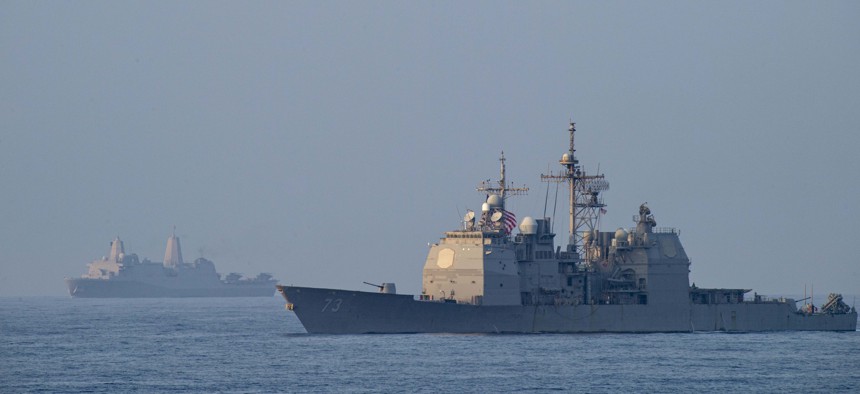
The Ticonderoga-class guided-missile cruiser USS Port Royal (CG 73) in the South China Sea April 9, 2021. DoD
The Naval Brief: Cruiser warning, Swimming Marines, Shipyard delays, and more...
Welcome to the inaugural issue of The Naval Brief, a weekly look at the news and ideas shaping the sea services’ future.
Budget posturing. While everyone waits for the Biden administration to reveal its first budget request, lawmakers are setting out their preferences. Rep. Rob Wittman, R-Va., ranking member of the House Armed Services Committee’s seapower panel, is stumping for a DoD topline of $753 billion, roughly the 2021 budget plus inflation and more than the announced $715 billion Biden topline. At this week’s McAleese defense conference, Wittman also warned the Navy that abruptly retiring the remaining Ticonderoga-class guided-missile cruisers would be a non-starter. “I’m not saying that we shouldn’t retire those systems. I’m saying we have to do it the right way. We have to make sure that we have a transition plan; say, ‘Okay, as we lose these number of cruisers, we lose these number of missile tubes, how are we going to replace them?’”
Marines swim toward the future. The first 138 Marines graduated last week from the new Infantry Marine Course, whose final exercise simulated a 300-yard swim in full battle rattle through — you’ll never guess — the South China Sea. Marine instructors created the Camp Pendleton course in response to Gen. David Berger’s 2019 Commandant’s Planning Guidance, which aims to move the Corps away from 20 years of desert warfare and back to its amphibious roots. Though newly minted Marines have generally emerged from boot camp with some swim training, the new course aims to produce warriors who can fight from the sea — or at least survive a training accident.
Fixing shipyard delays. The Navy has slashed the number of steaming days lost to unplanned delays in shipyard maintenance, reducing delay days by 80% at public yards and about 60% at private ones, Chief of Naval Operations Adm. Mike Gilday said May 6 at a U.S. Navy Memorial event. About a third of the delays were caused by inadequate planning: maintenance contracts were being cut just 30 days before a ship arrived at a yard. Gilday said the Navy is now cutting contracts an average of 97 days before the work begins, and he’s pushing for 120. You can watch more of his talk here.
Massive weapons seizure. The guided-missile cruiser USS Monterey and a Coast Guard advanced interdiction team found thousands of weapons aboard a stateless dhow in the North Arabian Sea May 6. The weapons included “dozens of advanced Russian-made anti-tank guided missiles, thousands of Chinese Type 56 assault rifles, and hundreds of PKM machine guns, sniper rifles and rocket-propelled grenades launchers,” as well as advanced optical sights, according to the Navy. The origin and intended destination for the weapons is still being investigated, but a Fifth Fleet spokesman told CNN that previous weapon seizures like this one were bound for Houthi rebels in Yemen.
Sign up to get The Navy Brief every Thursday morning. On this day in 1908, President Theodore Roosevelt signed the Naval Appropriations bill that established the Navy Nurse Corps.
 From Defense One
From Defense One
Some US Military Bases Begin to Loosen Mask Rules // Jennifer Hlad: As some states drop COVID restrictions, commanders from coast to coast are attempting to walk a safe line.
What's In Biden’s First Budget? And How Late Will It Be? // Marcus Weisgerber: The White House could submit its defense budget request later than any administration in at least a century.
US Marines May Have Lost Their ‘Amphibious Edge,’ Leaders Say // Elizabeth Howe: Top Marines tell Congress that after deadly AAV accident and years in Middle East, the Corps and its vehicles are unprepared for waterborne operations.
US Air Force, Navy Extend 50% Work-From-Home Indefinitely // Marcus Weisgerber and Tara Copp: New memos suggest office space occupancy may never return to 100 percent.





